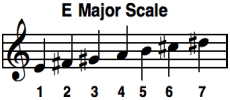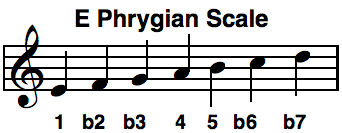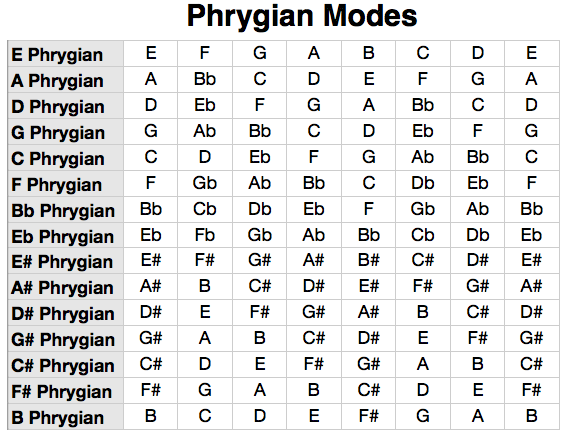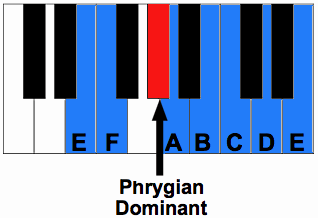The Phrygian scale is a very common musical mode used by Jazz musicians. I like to call it the Spanish-Bullfighting scale. It has a very unique sound that almost has a Spanish feel to it.
The Phrygian mode is great for soling and improvising. Once you learn it, you will be able to easily add a lot of variation to songs. It also gives a song a twist that the usual Major Scale can’t.
There are a lot of Jazz songs that use this mode, among many other genres. Let’s get started!
The Phrygian Scale
Like other modes, the Phrygian Mode is an alteration of a major scale.
Generally, a major scale starts and ends on the “Root Note” of the scale.
For example: If you were playing the C Major Scale, you would start and end the scale on C.
When you play a musical mode, you start and end on a note rather than the root. To make the phrygian mode, you would start on the third degree above the root.
In the key of C, this would be an E note.
Play the same notes that are in the scale, just start and end on the third note in the scale rather then the root.

Quick Tip!
E Phrygian Notes: E, F, G, A, B, C, D, E.
Notice in the picture that the notes in E phrygian are the same notes that are in the C major Scale.
This can be done in every key on the piano making there 12 different phrygian modes.
Phrygian Mode Internals
What makes a mode different from other scales is its unique set of intervals that they have.
A normal major scale has a set of intervals that make it sound very plain. Not that its plain, it just sounds very natural. Everything is where its supposed to be, it resolves to the root, it’s just not very distinct sounding.
Major Scale Intervals:
Whole Step – Whole Step – Half Step – Whole Step – Whole Step – Whole Step – Half Step
This scale has a totally different sound. Because the intervals are different, the sound of the scale is very different.
Phrygian Mode Intervals:
Half Step – Whole Step – Whole Step – Whole Step – Half Step – Whole Step – Whole Step
Here is an audio sample of both the major scale and the E Phrygian Scale. Notice the difference in the intervals that make the scales sound different.
Major Scale
Phrygian Scale
Building a Phrygian Scale
To build a Phrygian Mode, start by looking at the major scale of the scale in question. For example, if you want to find E Phrygian, you would look at the E Major Scale.
The E major scale has four sharps and contains the notes E, F#, G#, A, B, C#, D#, E.
In order to make E Phrygian, you would flat the second, third, sixth, and seventh notes in the scale. By making these notes flat, you now have the E Phrygian Mode.
Quick Tip!
Phrygian Scale Formula: 1, b2, b3, 4, 5, b6, b7.
Look at the image below and see how you build a Phrygian mode by first building the major scale
 |  |
Parallel Scales
You can also build a phrygian scale by moving up or down a major third. A major third is equal to the distance of four half-steps, or the third note in a major scale.
If you want to know what scale to play over phrygian, move down a major third.
For example: If you want to know the notes in C Phrygian, you would move down the piano a major third, which would land you on A Flat. This means that an Ab Scale contains the same notes as C Phrygian.
This also works if you want to know what phrygian mode to play for Ab. Start on Ab and move up a major third to C. This shows that C Phrygian is a parallel scale with Ab Major and contain the same notes.
Phrygian Notes
The notes in the Phrygian scale always contain a b2, b3, b6, b7. Rather than having to take the time to figure this out every time, use the chart below to help you know the note in every Phrygian mode.

For all the notes on the staff for each scale, click here to download and print a PDF copy of the sheet music below.
 |  |
 |  |
 |  |
 |  |
 |  |
 |  |
 |  |

Applying Phrygian
There are a few ways to use phrygian. The easiest way is to play phrygian over a Minor 7 chord.
Because of the b3 and b7 in the scale, it creates a min7 chord. Since the minor 7 chord is the root for this scale, you can play phrygian over a min7 chord.
This scale is most generally used in chord progressions starting on a minor 3 chord. If you are in the key of Ab, the minor 3 chord is C Minor.
Quick Tip!
Common Phrygian Chord Progression: iii – IV – V
Make sure that when playing in phrygian that you always resolve back to the root of phrygian mode. If you are playing in C Phrygian, make sure that the tonal center of the song is based around C, note Ab. Even though Ab is the parallel scale, make sure to use C as the new center for the scale.
Phrygian Natural Third/ Phrygian Dominant
Another great way to use the Phrygian scale is by adding the natural third, also known as phrygian dominant.
Phrygian Natural Third is the exact same scale as the original phrygian, except it has a natural third instead of a flat 3rd.

Quick Tip!
Phrygian Natural Third Pattern: 1, b2, 3, 4, 5, b6, b7.
The only difference is that the 3rd note is natural instead of flat.
Using this scale in conjunction with the original phrygian scale can add some great alternate harmonies. Using phrygian dominant is where the Spanish Bullfight sound comes from.
Use this scale from time to time with the phrygian scale.
Remember to change the tonal center of the song to the mode you are playing in. Playing C phrygian with the tonal center of Ab would defeat the purpose of using this mode.
To get the most out of this musical mode, remember to make the tonal center of song revolve around the mode, note the parallel scale.
Go From Phrygian Scale Back to Musical Modes
Back to Home Page
